- Images
- Blog
- Tools
- Questar
- The Questar telescope
- Questar resource links
- Search for Questar info
- 172mm Focal Reducer
- Afocal adapter for point and shoot camera
- Camera adapter lengths
- Camera adapter threading
- Camera connection
- Camera focusing
- Custom counterweight
- Drift Alignment Joy
- Finder Eyepiece Compatibility
- The Questar Moon 1981
- Questar Powerguide II Battery Life
- Questar Zone, How to Service Videos
- Red Dot finder mount for Questar
- Questar Viewing Table
- Wedge mounts
- White light solar filters comparison
- How to
- Get started in astronomy
- Astro RaspberryPi Camera and kin, the ASIAir and StellarMate
- Blind Smart-phone Equatorial Wedge or GEM Polar Alignment
- Camera phone adapter
- Celestron FirstScope with equatorial tripod mount
- Coat Pocket Astrophotography
- Day-lapse Images of Earthshine on the Crescent Moon
- Dobsonian Carrying Case
- DSO Astrophotography without a Telescope
- DSO imaging without a star tracker
- Estimating image resolution
- Lunar Eclipse Photography
- Moon photography - a dozen ways to shoot the Moon
- Meteor shower photography & planning
- Matching image sensor size to telescope resolution
- Narrow band imaging with color cameras
- Planetary Image Workflow
- Print and Display Astrophotography
- Observing
- Events
- More
- About
- Contact
Day-lapse Images of Earthshine on the Crescent Moon
The crescent Moon with earthshine is an inspiring site in the night sky. Earthshine images that capture the beauty seen by eye or through a telescope are rare. The extreme range of light and glare from the lunar crescent make it difficult to capture, with a camera, what the eye sees. Conventional High Dynamic Range (HDR) techniques require many exposures and careful processing to give good results. A simple technique, day-lapse earthshine imaging, produces stunning images of the Moon. Earthshine detail, right up to the terminator, duplicates the view of the eye through a telescope. This is done using just two exposure settings.
Our eyes can see a larger range of light than the best cameras. HDR photography captures details in highlights and shadows. Multiple images taken at different exposures capture a scene’s full range of light. Post-processing merges the images to produce a single HDR image without over or under-exposure. A typical daylight terrestrial HDR image includes three exposures taken about a stop (2X) apart to capture details in shadows and highlights.
The Moon with earthshine is very challenging to the HDR photographer. The sunlit portion of the Moon is bright and can be captured well by a single camera exposure. The rest of the Moon is dimly lit by earthlight, sunlight reflected from the Earth to the near side of the Moon. Because the Moon has no atmosphere, the terminator dividing lunar day from night is sharp. The difference in light levels between the crescent and earthshine is 8 to 10 stops (1000X).
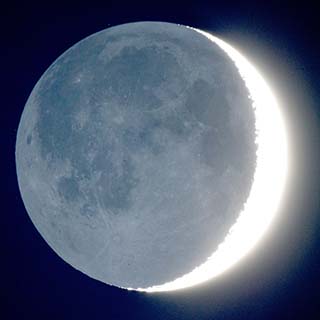
Taking just two exposures 8 to 10 stops apart and combining them into an HDR image doesn’t work well. The earthshine exposure above is spoiled near the terminator by glare from the badly overexposed crescent. A cropped HDR composite with the crescent exposure included (figure below) shows two problems: glare from the bright crescent and a shift in the apparent location of the terminator.
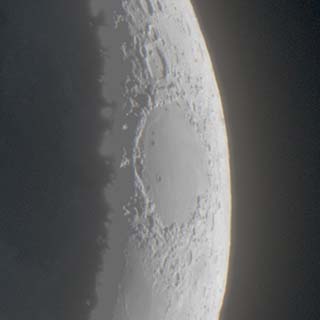
This shift in the apparent location of the terminator is due to the very low angle of the Sun near the terminator. This dimly lit area along the terminator is dark in the short crescent image exposure and overexposed in the earthshine image. This region is often painted out in earthshine images. The image looks better, but any detail in this part of the Moon is lost in a grey blur. Increasing the number of HDR exposures (8 or more are needed) can capture detail in this region of low angle sunlight. Many more exposures at different settings make this more difficult to shoot and process. Reduced contrast because of glare from the crescent is still a problem in HDR images with many exposures.
Other techniques used to improve image quality require even more exposures. Lucky image stacking combines the best of multiple images of a target to reduce noise and increase contrast. If we improve image quality by image stacking, many hundreds of images must be taken. Using a video camera speeds up the exposures at a cost. Video gives lower resolution images or requires even more images to stitch together into high resolution mosaics.
The earthshine photographer needs techniques that can capture the whole lunar disk, with high resolution, and require the fewest possible exposure settings for HDR. DSLR or mirrorless cameras with APS-C or larger sensors are a good match for capturing the full Moon in a single exposure with most telescopes.
A night’s rest provides an simple solution to the many exposures problem… The terminator advances about 12 degrees across the Moon’s face each day. We only have to add delay between exposures. With enough delay, the detail hidden by glare and terminator shift is revealed by the advancing terminator. A day or two wait between just two exposures is enough. With only one exposure setting needed per night, it’s easy to take extra images for lucky image stacking. Detail in the earthshine will always be softer and lower contrast than in the crescent because of the dim, diffuse lighting from the nearby earth. Craters, highlands, and maria in the earthshine area are visible right up to the terminator in day-lapse earthshine images. They closely match the beauty of this scene in a telescope eyepiece.
Some fine points require attention. The apparent size of the Moon changes slightly because of distance changes due to its elliptical orbit around the earth. The portion of the Moon that we can see changes slightly because of the tilt between Earth’s rotation and the Moon’s orbit. Libration changes our perspective because the Moon’s orbit is tilted with respect to its axis. A small change in the Moon’s size is easy to correct during alignment. Large perspective changes cannot easily be corrected. With only a day or two delay, they can be corrected by aligning and transforming the earthshine layer to match the crescent layer features along the terminator. Corrected, small size and perspective changes are too small to see in the final result. For a waxing crescent take the earthshine exposure on the first day, for a waning crescent take it on the day following your crescent exposure.
There are too many software tools for processing HDR images to give details for each. Adapt these suggestions from my processing workflow to your own tools.
If you stack multiple images to improve the image quality, you need to deal with atmospheric seeing. The Moon has about 1/2 degree of apparent size. Variations in atmospheric seeing result in mirage-like distortions across the Moon. This makes lucky image stacking more difficult for full-disk Moon images than for lunar close ups. Align images using a stacking tool that corrects for geometric distortion. I use Nebulosity's non-stellar automatic alignment, with 8 parameter affine transform, very successfully. Alignment is slower, but the results are worth the wait.
Three layers are needed for two exposure HDR image merging in a layer based editor like Photoshop. The background layer is black. Lunar detail and background stars are picked up from the top two layers.
The earthshine layer is next; masked to include only the lunar disk shown. On this layer, I select the overexposed crescent area, and clone color sampled from the earthshine region. This will insure the correct level of earthshine illumination in the terminator and crater shadows in the brightly lit crescent.
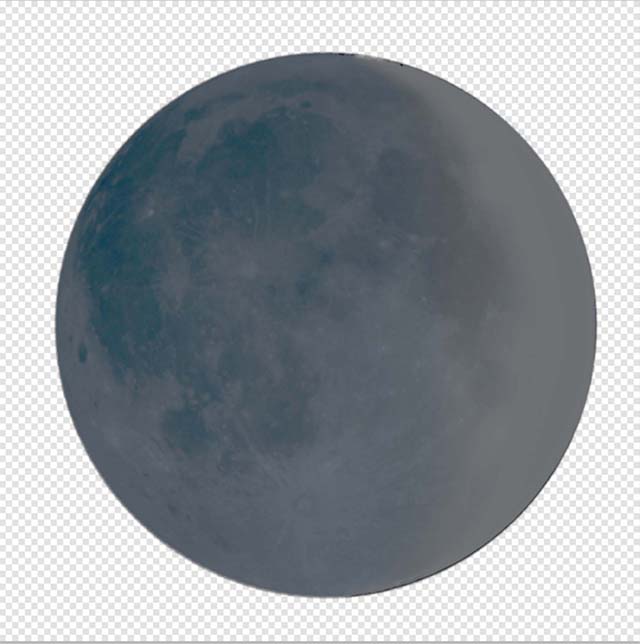
The top layer is the exposure for the sunlit lunar crescent shown below. The earthshine layer must now be translated, rotated, and scaled to align to features on the crescent terminator. The final HDR merging is done by setting the top crescent layer to "lighten only" merge. The final balance between crescent and earthshine illumination is achieved by adjusting each layers exposure individually.
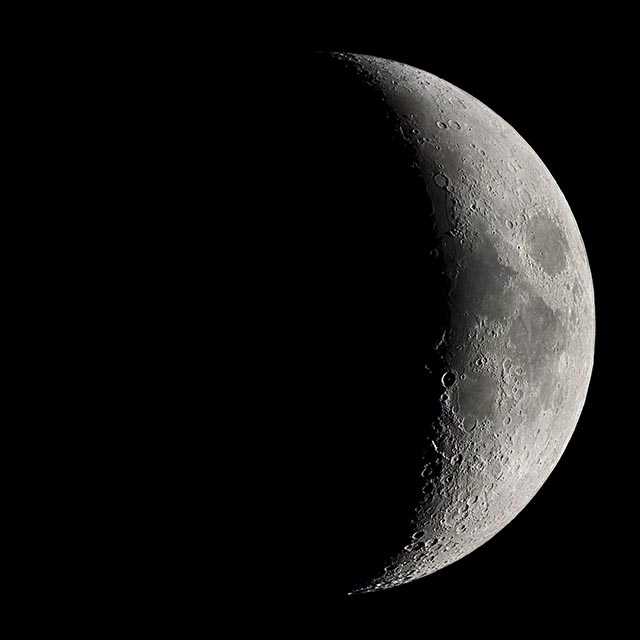
The final result below captures with fidelity the appearance of the Moon in the eyepiece when the crescent image was made. This image was made with small, light equipment, an 89mm f14 telescope and a 16 megapixel mirrorless APS-C camera at prime focus. The earthshine layer was exposed for 2.5 sec at ISO 800 with 14 frames stacked. The crescent layer was exposed 2 days later for 1/15 sec at ISO 200 with 9 frames stacked.

Compare this day-lapse image with these exceptional images made using conventional HDR techniques: Jerry Lodriguss's two-day old waxing crescent Moon and Dylan O'Donnell's March 20, 2015 Astronomy Picture of the Day.
Try this day-lapse technique with your own images and tools. Problems from glare and camera limitations will be gone. You will soon be making great earthshine images that capture the beauty of the scene as you see it through the eyepiece.
A very thin crescent, only a day or so from the new Moon, is relatively dim and reduces the exposure difference between earthshine and the crescent. This makes it easier to produce a good image without the need for the day-lapse technique:
Here are some more examples of the day-lapse technique. The image below was awarded 2nd place for the Astronomical League 2017 OPT Solar System Imaging Award.
Other astrophotographers from around the world are now using the day-lapse technique as well. Here's an example from Roch Lévesque. If you post any of your day-laps images, tell me about them, and I'll include them here.
Content created: 2015-05-29 and last modified: 2017-10-03
Comments
![]() Submit comments or questions about this page.
Submit comments or questions about this page.
By submitting a comment, you agree that: it may be included here in whole or part, attributed to you, and its content is subject to the site wide Creative Commons licensing.

How to
Starter telescopes for beginners
Getting started in astrophotography?
Choose & setup a camera for astrophotography
Astro RaspberryPi Camera and kin, the ASIAir and StellarMate
Blind Smart-phone Equatorial Wedge or GEM Polar Alignment
Celestron FirstScope with equatorial tripod mount
Day-lapse Images of Earthshine on the Crescent Moon
DSO Astrophotography without a Telescope
DSO imaging without a star tracker
Overview & equipment for lunar eclipse photography
Framing and tracking a lunar eclipse
Moon photography - a dozen ways to shoot the Moon
Meteor shower photography & planning
Matching image sensor size to telescope resolution
Narrow band imaging with color cameras
Print and Display Astrophotography
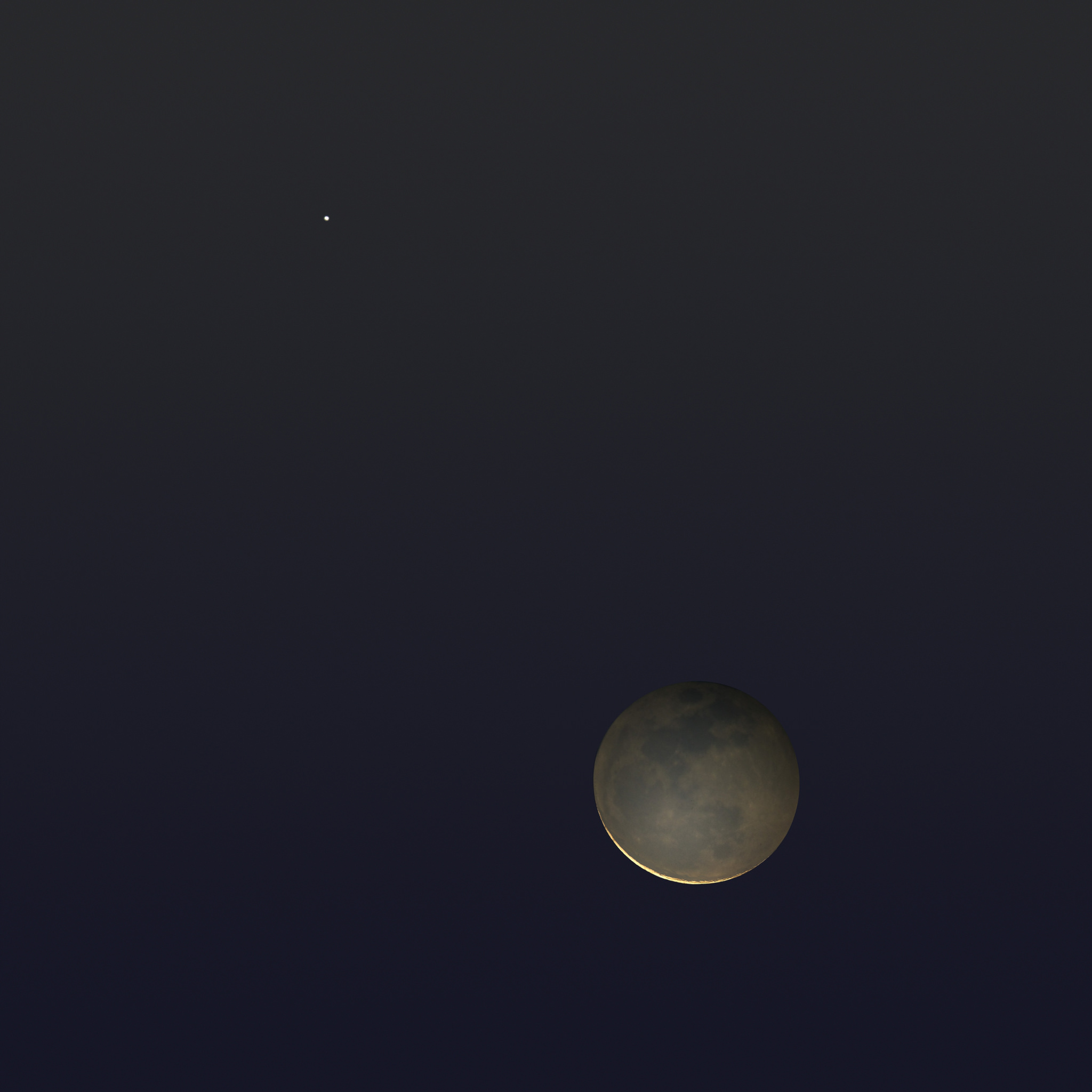




 Get started in astronomy
Get started in astronomy